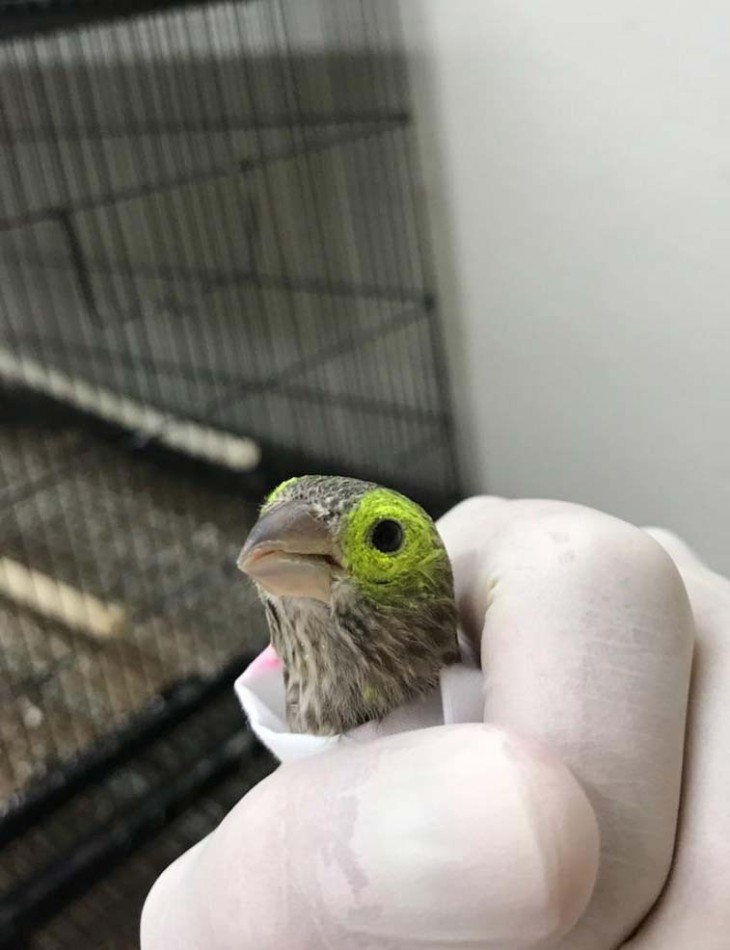
In the mid-1990s, bird-watchers near Washington, DC, began to notice something alarming. House finches at their feeders appeared to be sick, with red, swollen, watery, or crusty eyes. Some birds were completely blind and struggling to eat, preferring to remain on the ground in search of fallen seeds. Many began to die from starvation, exposure, or inability to flee from predators. It was soon confirmed that they were afflicted with avian conjunctivitis (or mycoplasmal conjunctivitis), an infection of the eye that afflicts some species of songbirds, primarily house finches (Haemorhous mexicanus).
Avian conjunctivitis is caused by a parasitic bacterium, Mycoplasma gallisepticum (Mg), that house finches likely acquired from poultry. From when it was first detected in house finches, the disease spread quickly among populations on the Eastern Seaboard, to the Rockies in a matter of years, and to the West Coast within a decade. Because house finches are a social species that typically congregate in flocks, researchers originally thought that higher social status among the flock (greater number of individual connections) was a contributing factor determining rates of transmission. More recent research is shifting those assumptions.
Dr. Dana Hawley of Virginia Tech has been investigating the physical and behavioral mechanisms of transmission of the disease. In a 2021 study, Hawley and her team outfitted house finches with electronic transmitters that recorded their proximity to one other, and then tested each for Mg. They found that birds that visited feeders with the greatest frequency were the most likely to contract and spread the disease, not those with the most social contacts. In a separate study, they found that a higher density of feeders in an area contributed to a greater rate of transmission. They were able to confirm that birds were primarily acquiring and passing the disease not from each other, but from indirect contact at feeders. Hawley suspects that the bacterium is able to survive on feeder surfaces for 4 to 8 hours after an infected bird scratches or rubs its eye there.
The strain of Mg that infects house finches no longer infects poultry, and vice versa. In fact, research led by Dr. André Dhondt and Dr. Wesley Hochachka of the Cornell Lab of Ornithology has shown that the house finch immune systems have been engaged in an evolutionary arms race with the bacterium. Using genetic analysis, they found that while infection rates have remained relatively constant across house finch populations, new variants have become established that have caused peaks in disease. Much like human epidemics, Mg is perpetuated by continuing to find unexposed hosts, such as new fledglings each year.
Native to the western United States, house finches are considered by some conservationists to be an invasive species in the East. A small number were introduced on Long Island in the 1940s, likely via pet dealers after their sale was banned. Their fondness for nectar has given the birds a reputation as a nuisance to hummingbirds and scientists believe that their affinity for suburban areas has pushed purple finches (Haemorhous purpureus), which occupy a similar niche, back to forests. Better understanding these demographic and interspecies relationships may help researchers predict disease transmission and prevent spread at communal gathering places such as feeders and water sources.
But one question still remains: why house finches? Because Mg is host-specific, cell surface receptors unique to the family Fringillidae (finches and grosbeaks) likely play a role in vulnerability to disease.
“There’s something physiological that makes them more susceptible, but we don’t really know what that is at this point,” Hawley said. The low genetic diversity of eastern populations (all descendants of the initial introduction) was also probably a contributing factor to the disease’s rapid spread and high fatality rate during the initial wave.
According to both research groups, though, low-dose exposure seems tied to antibody creation and an increased ability to fight off Mg. “It’s possible to effectively vaccinate themselves by becoming exposed to a small number of bacterial cells,” said Hochachka. But he went on to say that due to its already high prevalence in wild populations, “Management is out of the question.”
Work will instead continue to be focused on monitoring and understanding the genetic and behavioral mechanisms of spread. Such work is important to preventing epidemics of Mg in other songbirds, as well as learning to detect and contain other poultry pathogens before they can jump to wildlife or humans.
How You Can Help
Wash your bird feeders regularly by soaking them in a dilute bleach solution or boiling water and drying them completely. If you see any infected house finches, take down your feeders for up to a week or more and report your observation to Project Feederwatch.



